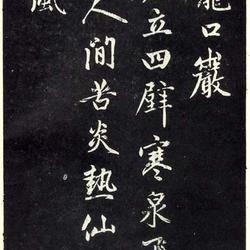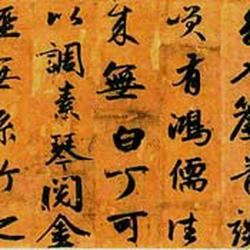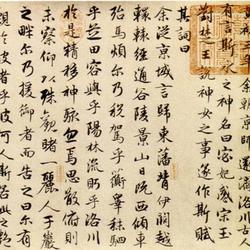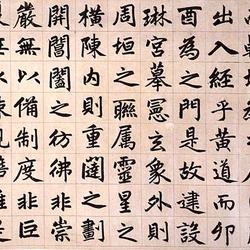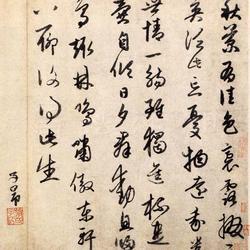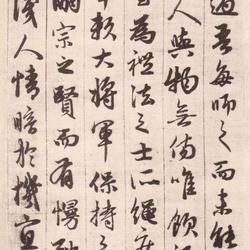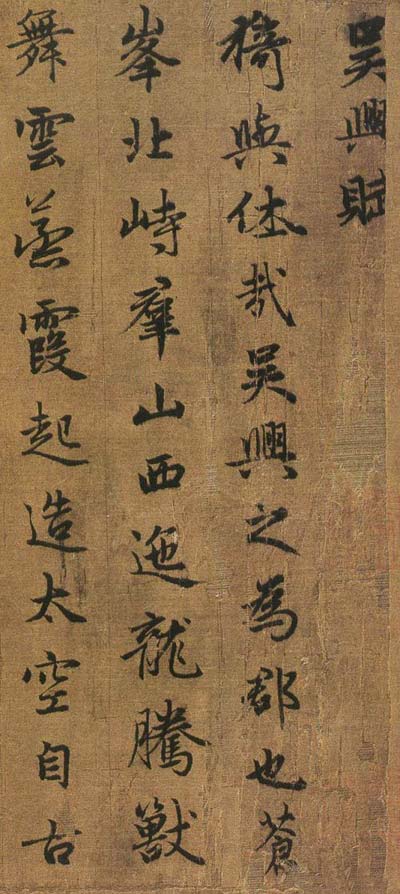 Zhao Mengfu's "Wu Xing Fu" is 282.95 cm long and 25.8 cm high. The album pages are folded into a long scroll. It was originally collected by the Palace Museum in Beijing. In 1955, through the contact and negotiation of the famous calligrapher Mr. Sha Menghai, it was put into the collection of the Zhejiang Provincial Museum until now.
Zhao Mengfu's "Wu Xing Fu" is 282.95 cm long and 25.8 cm high. The album pages are folded into a long scroll. It was originally collected by the Palace Museum in Beijing. In 1955, through the contact and negotiation of the famous calligrapher Mr. Sha Menghai, it was put into the collection of the Zhejiang Provincial Museum until now.
"Wu Xing Fu" is Zhao Mengfu's favorite calligraphy work, and the content of the calligraphy was written by himself. As far as the latter is concerned, it is rare among his handed down works.
Explanation:
Yi and Xiuzai: Wuxing is a county, with Cangfeng standing in the north, mountains winding to the west, dragons soaring and beasts dancing, clouds steaming and clouds rising, creating space. Since ancient times, there have been two streams flowing between them, and those who come from the sky are three hundred miles away. It twists and turns, creating ripples, forming a bay, and converging into a lake. The water is clear and clear, with no mud for a hundred feet, running through the city, lingering in the surrounding areas, and filling the east area, with the sky as the embankment. , Otherwise, I don’t know why I accept it. I watch the mountains and rivers reflect, the sun and moon shine brightly, the clear air is bellowing, and it rushes and gathers. The stars are arrayed in Douye, the power is as powerful as Chu and Yue, the place where Shen Yu is settled, and the place where Taibo is dying. Since the beginning of the Han Dynasty, when the country was often founded, the city of Jin was built to capture the show and the truth, and thousands of pheasants were flowed along the river to form towns. Therefore, careful shepherds in the past dynasties must recruit great talents and select knowledgeable people. There are Wang, Xie, Zhou, and Yu in the front, and He, Liu, Yan, and Su in the back. Their styles reflect each other, and their governance and conduct are consistent. They all declare their virtues and entertain the people. What's more, what the land produces and the customs are suitable for it, people have nothing to ask for and have more than enough to use. To the east are acres of fields covered with mud and plaster, where the wheat is harvested and the stems of the rice are harvested. The jade grains are as long as the waist, and the juju and boxes are illuminated and transported to other counties. There are always no bad years. To the south is Fuhu Mountain and the foothills of the Golden Gai. There are buoys on the top, orchids perch on their feet, drums and bells can be heard, flying deer and Huahuang. Hengshan has no water. According to the records of Lu, there are winding canines and Pize. There are solitary trees, lotus blossoms, water chestnuts, and cattail trees. You can look around and see countless things! Among them, there are bream, carp, minnows, needle-headed white small fish, perch, mandarin fish, turtles and turtles. There is a mosquito dragon, and the long fish is like entering, spraying the waves to create the wind, and making a hundred moves with one move. The fisherman comes to join him, and he is doing his job in covering Shantou. , the days are endless. To the west are mountains and ridges, and Sichuan is here. To the north is the Cave of Huanglong Yaofu, an exquisite and long-lived dock, with hundreds of meters of suspended water. It is both high and blocked, with stones inlaid in it, and thousands of strange rocks, making it look like a forest. In its high hills, there are bayberry, jujube, hawthorn pear and papaya, orange and pomelo in summer, loquat in winter, locust, sandalwood, pines and cypress, and tung tree and catalpa. Wen poles of green bamboo, Xiao Yuan mixed with cyanosis, taste like beans, talent in the palace, down to catch the firewood woodcutter, everything is possible. On the flat land, there are mulberry and hemp trees like clouds, which are dense and dense. The fine vegetables contain liquid and do not store new growth. The pheasants and rabbits are hunted on the land, and the geese are hunted by the water. The advantage of the boat is more than half. Food and clothing nourish the people, and they are both happy and humble. So there was Mr. Ji Shen, who followed the path of the Ming sages, built a school, set up a preface, served Fengye, Dai Zhangfu, helped many scholars, and became one of the ancients. Then choose the first day, use the measured coins, respect the Xuan wine, use the Chen Fu and Gui, select the capable ones, follow the Zhou etiquette, put those who praise in front, those who offer in the back, look down gracefully, follow the rhythm, and retreat after completing the ceremony, with the gods and people on your right. At that time, there were poems and books in the family, households practiced the way of honesty and shame, the laws were adopted by Yong, and the counties observed the effect. It was an immortal event. It may be difficult to say: "Since ancient times, scholars who have commented on books have never understood the characters and records. What about customs? Talents are tools that help the time, and customs are the essence of governance. Today, I only pick up the details, compare the goods and food, talk without thinking, and show off. There is nothing greater than these two. I will not record it briefly. Although the text is seizing the embroidery, and the sound is harmonious with gold and stone, the theft is for the son and he will not take it." The servant responded and said: "No. Is it true that the son alone does not hear the words of the master? 'In a city with ten houses, there must be loyalty.' This year and thousands of years , the land is thousands of miles away, the people are rich, Hu Ke is not recorded! The history book is complete, there is no need for redundancy. If it is the ups and downs of customs, it is impossible to get them because of the changes of the politicians. Although the husband and Wu were divided In Jiangzuo, I have experienced the most virtuous wind. And I heard that the wind is moving while the grass is dying. At noon, it shows the uprightness. It goes up and down and takes effect. It sends orders by post. It is guarded by Jizi, and it is made by words and travels, and it is transformed by benevolence and righteousness. , Ritual and music are the basis of government, and the treasure of non-greed is used as a treasure. It is a metaphor for unspoken faith. That is, punishment can be used without using it, and customs can be used to promote prosperity. Only then can we return to the simplicity of the ancient times, and the test of rest will be auspicious to the common people. The beauty of today is It's beautiful, and you can think of it as settled: "So the difficulty is only Wei Wei, wandering around and frustrated."
Appendix Zhao Mengfu and his calligraphy "Wu Xing Fu"
Author: Wang Hongli (published in the fourth issue of "Calligraphy" magazine in 1996)
Zhao Mengfu (1254-1322), whose courtesy name was Zi'ang, also known as Songxue Daoren, was a famous writer, musician, painter, and calligrapher in the Yuan Dynasty. He was the tenth generation grandson of Taizu of the Song Dynasty. He was a native of Wuxing because his fourth ancestor was granted Huzhou. At the age of fourteen, he used his father's influence to supplement his official position. After the death of Song Dynasty, he lived in seclusion in his hometown and studied diligently. Later, he came to Beijing because of the imperial court's search for relics in the south of the Yangtze River. Seeing his talent and extraordinary spirit, Emperor Shizu of the Yuan Dynasty was pleased to grant him an official position. In the evening, due to his wife's illness, she was ordered to return to Wuxing. He was sixty-nine years old and was given the posthumous title Wenmin.
The original biography of "Yuan Shi" states that Zhao's "seal, 瀱, fen, li, xing and cursive scripts are all unrivaled in ancient and modern times". Tao Zongyi of the Ming Dynasty said in "Zhuigeng Lu": "The reason why Gong's calligraphy is wonderful is that he can't practice it without writing." Pei Jingfu, a recent scholar, quoted his predecessors in "Zhuang Tao Pavilion Calligraphy and Painting Lu" and cited his experience in learning calligraphy, thinking that " Songxue's calligraphy style changed three times. Before Yuanzhen, Siling's writing method was still followed; in the fifth year of Dade's reign, Dugu Dingwu's "Lanting" was obtained, and he began to pursue Shanyin with determination; Yanyou later followed Li Beihai's sincere hanging method." Later generations mostly relied on what he said, or thought that he learned from Xi in his later years. Is this true? The fifth year of Dade was 1301 AD, when Zhao was forty-eight years old. This can be seen from the "Wuxing Fu" written in this period.
Zhao Shi said at the end of the volume of the ink version of "Wuxing Fu": "I wrote this poem when I was more than 20 years old, and now I am 9 out of 40... I will record it on the 23rd day of February in the sixth year of Dade." According to what was said before, this is the right time. When Zhao first got involved with the King's Book, looking at this scroll, he was already familiar with the King's Book.
A closer look at Zhao's book traces shows that the two kings were traced back to the 21st year of the Yuan Dynasty (i.e. 1284), which was around the time when Zhao was thirty-one years old. If this is the case, then when he wrote "Wu Xing Fu", he had been studying Wang's books for nearly twenty years, so his writing had the wonderful ability to enter and leave the right army and follow his heart's desire. Liu Chongqing's postscript at the end of the volume says: "Zhao Wenmin's true beauty and writing can be traced back to "Xiuhu" and "Holy Teachings", and he has gone beyond the slightest detail." Sincerity is not a lie.
However, because Zhao was able to master everything from brushwork, structure to charm, later generations may ridiculed him as a "slave calligrapher". If we argue with each other based on this, we can be forgiven in the end. However, reviewers have always used non-artistic standards, either valuing books based on people, or discarding books because of people. Naturally, it is not appropriate to draw a fairer conclusion.
However, Zhao Mengfu did not have the heroic feat of Wen Tianxiang who resisted the Yuan Dynasty and sacrificed his life, nor was he better than those who fled before the battle or surrendered their weapons when encountering the enemy. Although he was a descendant of the Song Dynasty, he was almost like a farmer and a wild man at that time, and his family was poor. The descendants of Zhao and Song Dynasty were only Poor body and ears. Of course, he was not without the consciousness of leaving behind young people. In the year when Wen Tianxiang was killed, he also voluntarily resigned from his position as editor of the Hanlin Academy of National History in the Yuan Dynasty. But in the final analysis, he was a typical intellectual in the feudal era, and his thoughts on seeking fame and honoring his ancestors were very clear. This thought became particularly strong when the Song Dynasty was overthrown and the family was in decline. When his father died at the age of eleven, his biological mother, Mrs. Qiu, said: "You are a young and orphan. You cannot improve yourself in learning. You will never be able to become an adult. This is the end of my life!" Emperor Gong surrendered to the Yuan Dynasty, and the Yuan army went south. Mrs. Qiu said again: "The Holy Dynasty will definitely recruit talented people from the south of the Yangtze River and use them. If you don't study a lot, why are you different from ordinary people?" Perhaps it was because he knew that the overall situation had been decided, so he also sang praises for the Yuan Dynasty a few years later, and did not listen to his friends anymore. Discouraged and embarked on an official career.
Zhao Mengfu did not act as a stooge in the court, but showed more of the character of an upright intellectual. As a scholar and a member of the Song Dynasty clan, it is naturally difficult to entrust him with important responsibilities. He can only go to the court to handle copywriting and enjoy the blessings of banquets and self-pity. Fortunately, the cold reception helped him. During his official career, he was able to see many famous inscriptions from the previous generation, which broadened his horizons, improved his horizons, and made great progress in the art of calligraphy.
From this point of view, we cannot simply judge Zhao as good or bad.
It is very clear that character is different from book quality. Of course, if someone's character is not high enough, he worries about gains and losses all day long, is unwilling to sit on the bench, does not think about progress in art, and only thinks about how to please others or be new, his artistic taste will naturally not be very high. As mentioned above, Zhao Mengfu did not lose the basic character of an old-time intellectual no matter in officialdom or in dealing with others. On the contrary, he always diligently pursued a simple and elegant high style in poetry, calligraphy and painting, which was not something ordinary people could compare with. Same thing. As for artistic style, it is actually composed of academic accomplishment, aesthetic ideals, etc., among which artistic personality and temperament play an important role.
Those who are "excellent" can be despised as "kitsch", and those who are "extraordinary" can be regarded as "treacherous". This is the traditional bad habit of discarding books because of people. Zhao Mengfu studied calligraphy with Zhao Gou in his early years, and Zhao Gou was also a master at imitating the king. His "Han Mo Zhi" says: "As far as the "Cunei Tie" is concerned, the measurement will be deeper and the imitation will be stricter. , and even became recited, many of which made me miss it." However, Zhao Mengfu obtained "Chunhua Pavilion Tie" and repeatedly observed the ink of the two kings, etc., which enabled him to better understand the true meaning of calligraphy, and also enabled him to surpass the people of the Song Dynasty and stand on par with the sages of the Tang Dynasty. Approaching the Wei and Jin Dynasties.
Although the calligraphy of the Song Dynasty was divided into two sects, calligraphy declined greatly due to the popularity of calligraphy in the Song Dynasty. And a group of famous calligraphy masters always make their own mistakes. Just as Su Shi said: "Although my calligraphy is not very good, it is very fast to come up with new ideas and not follow the ancients." But after all, famous masters such as Su and Huang have traditional skills. Profound, comprehensive artistic quality, and extraordinary talent. However, most people in the world lack skill and talent, so it is inevitable that calligraphy in the Song Dynasty will deteriorate. Because Zhao Mengfu clearly saw the shortcomings in the calligraphy world, he put forward the slogan of returning to tradition and revitalizing calligraphy: "The knot characters are passed down from time to time, and the use of pens is difficult through the ages." And he himself is a hands-on practitioner.
Of course, Zhao Mengfu pays attention to tradition and does not seek innovation and development. But for a person who followed the calligraphy of the two kings, he believed that "using a pen is not easy through the ages", so he could only work hard on the "knotting" of "passing down from generation to generation". This naturally increases the difficulty of its creation. Although Zhao is proficient in both regular script and official script, he is most famous for his regular script. It is not easy to create a new look in regular script, but we can clearly see the painstaking efforts he made in creating the "Zhao style".
Zhao's calligraphy is based on Xi's calligraphy. Looking at his stippling, although it is not as varied as "Ye Tie", you can taste more simple and natural interest. We can know this by corroborating the calligraphy of the Wei and Jin Dynasties unearthed in later generations with the authentic works of royal books handed down from ancient times. The predecessors may use this point to criticize Zhao Shu's mistakes, but they may not fully understand the path he followed the ancients. The regular scripts often contain behavioral meanings, which are undoubtedly taken from people from the Sui and Tang dynasties such as Zhiyong and Chu Suiliang. As a whole, it seems to have borrowed a lot from Chu Suiliang, Li Beihai, and Su Dongpo.
Zhao's regular script is solemn and simple, yet has a refreshing and vigorous air. Inheriting the past and present, it becomes its own style.
Precisely because Zhao Mengfu attached great importance to legal standards and strived for creativity based on tradition, he was able to create the Zhao calligraphy style that was unparalleled for a hundred generations under the fence of Xi Zhi. If Xi is elegant, Meng Fu will be smooth and smooth; if Xi is moist, Meng Fu will be stretched; if Xi is beautiful and straight, Meng Fu will be solid; if Xi is agile, Meng Fu will be graceful. Today, if we re-examine Zhao Mengfu with a calm and objective attitude and read "Wu Xing Fu" again, we may have different feelings.
"Wuxing Fu" ink by Zhao Mengfu, hand scroll, silk, 25.8 cm long and 282.95 cm wide. The first title is "Wuxing Fu", and the right side of the three characters is incomplete. The main text is ninety-one lines, with nine to twelve full lines of characters, totaling 935 characters. At the end of the article, there is Zhao's own postscript, which has three lines and 41 words. At the end of the volume, there is Liu Chongqing's postscript. There is a postscript by Li Zuoxian on the paper behind the water barrier. Since the "Zi'ang of the Zhao family" Zhu Wen seal, there are also seals of "Zhang Yingjia", "Donghai Zhangjia calligraphy and painting", "Zhang Yingjia seal", "Zhang Qiazhi seal", "Xiyi family" and other seals. The first four sides of the volume, the back volume Seven directions.
According to Zhao's postscript, this scroll is an old work written in the 6th year of Dade in the Yuan Dynasty (1301) when he was more than 20 years old and praised his hometown of Wuxing. The lyrics are luxuriant, graceful and elegant, yet fresh and natural. They are quite in the tradition of Han Fu and have the style of the Wei and Jin Dynasties.
The main line of this book is alternately alternated with cursive script and more cursive script in the latter part, which has the meaning of gradually entering a wonderful state. The stipples are elegant, the posture is stretched, the composition is neat, and the expression is consistent. This magnificent work is one of Zhao's masterpieces in his middle age. The hand scroll was originally stored in the Palace Museum. In 1955, it was collected by the Zhejiang Provincial Museum after a negotiation with Mr. Sha Menghai.

